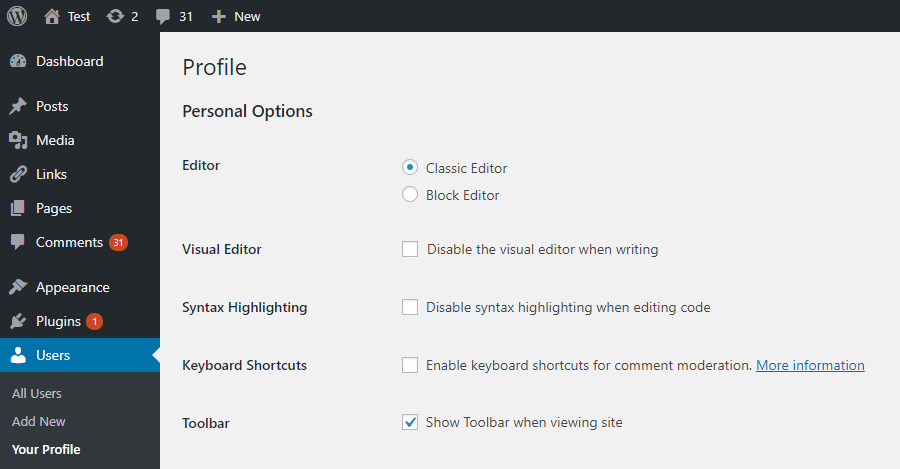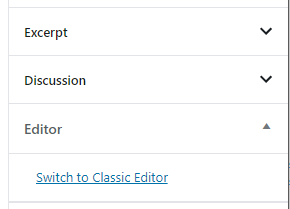Leírás
A Klasszikus szerkesztő egy hivatalos, a WordPress csapata által fejlesztett bővítmény, ami visszaállítja az előző (“klasszikus”) WordPress szerkesztőt és a megszokott szerkesztő felületet. Lehetővé teszi, hogy a bővítmények kiegészítsék ezt a felületet, hozzáadjanak régi típusú metadobozokat vagy biztosítsa a kompatibilitásukat, ha azok még ettől függenek.
A Klasszikus szerkesztő egy hivatalos WordPress bővítmény, ami teljes mértékben támogatva lesz legalább 2022-ig vagy addig, amíg szükség lesz rá.
Jelenleg ez a bővítmény a következőket nyújtja:
- Az adminisztrátoroknak lehetősége van a régi szerkesztőt alapértelmezettként beállítani az összes felhasználó számára.
- Az adminisztrátorok engedélyezhetik a felhasználóknak, hogy azok cserélhessék a szerkesztőket.
- Ha engedélyezett, akkor a felhasználók választhatnak, hogy melyik szerkesztőt használják minden egyes bejegyzéshez.
- Minden egyes bejegyzés a legutóbbi szerkesztésekor használt szerkesztővel jelenik meg, mert ez rendkívül fontos a következetes tartalomszerkesztés, karbantartás érdekében.
Továbbá a Klasszikus szerkesztő tartalmaz néhány filtert, aminek a segítségével más bővítményekből módosíthatók bizonyos beállítások vagy a szerkesztők választási lehetőségei az egyes bejegyzéstípusoknál.
Alapértelmezetten kikapcsolja az új Blokk szerkesztőt (“Gutenberg”) és visszaállítja a megszokott szerkesztő felületet.
Képernyőmentések

Admin settings on the Settings -> Writing screen. 
User settings on the Profile screen. Visible when the users are allowed to switch editors. 
"Action links" to choose alternative editor. Visible when the users are allowed to switch editors. 
Link to switch to the Block Editor while editing a post in the Klasszikus szerkesztő. Visible when the users are allowed to switch editors. 
Link to switch to the Klasszikus szerkesztő while editing a post in the Block Editor. Visible when the users are allowed to switch editors. 
Network settings to select the default editor for the network and allow site admins to change it. 
"Kapcsolás a Klasszikus szerkesztőre" hivatkozás
GYIK
- Alapértelmezett beállítások
-
When activated this plugin will restore the previous (“classic”) WordPress editor and hide the new Block Editor (“Gutenberg”).
These settings can be changed at the Settings => Writing screen. - Default settings for network installation
-
Két lehetőség van:
- When network-activated this plugin will set the Classic Editor as default and prevent site administrators and users from changing editors.
The settings can be changed and default network-wide editor can be selected on the Network Settings screen. - When not network-activated each site administrator will be able to activate the plugin and choose options for their users.
- When network-activated this plugin will set the Classic Editor as default and prevent site administrators and users from changing editors.
- Nem található a “Kapcsolás a Klasszikus szerkesztőre” hivatkozást
-
Ez a fő Blokkszerkesztő menüben van, nézzük meg a képernyőképet.
Vélemények
Közreműködők és fejlesztők
“Klasszikus szerkesztő” egy nyílt forráskódú szoftver. A bővítményhez a következő személyek járultak hozzá:
Közreműködők“Klasszikus szerkesztő” 52 nyelvre lett lefordítva. Köszönet a fordítóknak az áldozatos munkájukért!
“Klasszikus szerkesztő” fordítása a saját nyelvünkre.
Érdekeltek vagyunk a fejlesztésben?
Browse the code, check out the SVN repository, or subscribe to the development log by RSS.
Változási napló
1.5
- Updated for WordPress 5.2 and Gutenberg 5.3+.
- Enhanced and fixed the “open posts in the last editor used to edit them” logic.
- Fixed adding post state so it can easily be accessed from other plugins.
1.4
- On network installations removed the restriction for only network activation.
- Added support for network administrators to choose the default network-wide editor.
- Fixed the settings link in the warning on network About screen.
- Properly added the “Switch to Classic Editor” menu item to the Block Editor menu.
1.3
- Fixed removal of the “Try Gutenberg” dashboard widget.
- Fixed condition for displaying of the after upgrade notice on the “What’s New” screen. Shown when the Classic Editor is selected and users cannot switch editors.
1.2
- Fixed switching editors from the Add New (post) screen before a draft post is saved.
- Fixed typo that was appending the edit URL to the
classic-editorquery var. - Changed detecting of WordPress 5.0 to not use version check. Fixes a bug when testing 5.1-alpha.
- Changed the default value of the option to allow users to switch editors to false.
- Added disabling of the Gutenberg plugin and lowered the required WordPress version to 4.9.
- Added
classic_editor_network_default_settingsfilter.
1.1
Fixed a bug where it may attempt to load the Block Editor for post types that do not support editor when users are allowed to switch editors.
1.0
- Updated for WordPress 5.0.
- Changed all “Gutenberg” names/references to “Block Editor”.
- Refreshed the settings UI.
- Removed disabling of the Gutenberg plugin. This was added for testing in WordPress 4.9. Users who want to continue following the development of Gutenberg in WordPress 5.0 and beyond will not need another plugin to disable it.
- Added support for per-user settings of default editor.
- Added support for admins to set the default editor for the site.
- Added support for admins to allow users to change their default editor.
- Added support for network admins to prevent site admins from changing the default settings.
- Added support to store the last editor used for each post and open it next time. Enabled when users can choose default editor.
- Added “post editor state” in the listing of posts on the Posts screen. Shows the editor that will be opened for the post. Enabled when users can choose default editor.
- Added
classic_editor_enabled_editors_for_postandclassic_editor_enabled_editors_for_post_typefilters. Can be used by other plugins to control or override the editor used for a particular post of post type. - Added
classic_editor_plugin_settingsfilter. Can be used by other plugins to override the settings and disable the settings UI.
0.5
- Updated for Gutenberg 4.1 and WordPress 5.0-beta1.
- Removed some functionality that now exists in Gutenberg.
- Fixed redirecting back to the Classic Editor after looking at post revisions.
0.4
- Fixed removing of the “Try Gutenberg” call-out when the Gutenberg plugin is not activated.
- Fixed to always show the settings and the settings link in the plugins list table.
- Updated the readme text.
0.3
- Updated the option from a checkbox to couple of radio buttons, seems clearer. Thanks to @designsimply for the label text suggestions.
- Some general updates and cleanup.
0.2
- Update for Gutenberg 1.9.
- Remove warning and automatic deactivation when Gutenberg is not active.
0.1
Induló kiadás